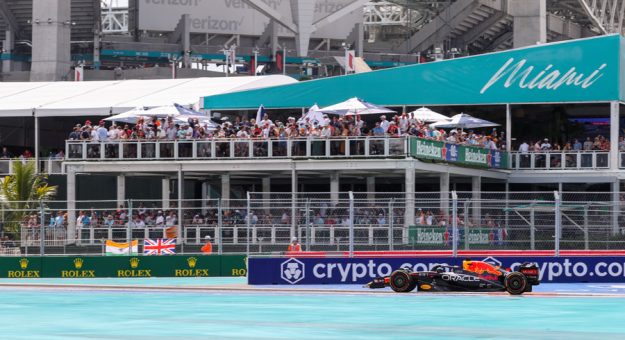WILMETTE, Ill. — As racing continues to return toward normalcy, new venues and events are creating positive excitement. This month, we will examine the numbers behind the resurgence of Formula 1 in United States.
There is a solid history of racing in Miami.
Carl Fisher, builder of Indianapolis Motor Speedway, constructed a 1.25-mile board track there in 1925. He imagined the area becoming the winter auto racing capital of the world.
The following year a hurricane destroyed the track and eventually Daytona Beach became The World Center of Racing.
Fast-forward to the 1980s, when Ralph Sanchez brought racing back to the Miami area. It ran in various locations over the years — Tamiami Park, Bicentennial Park and Bayfront Park. These street circuits primarily hosted open-wheel and sports car races.
Temporary courses are subject to numerous factors that affect their long-term viability. The devastation of Hurricane Andrew offered a redevelopment opportunity for a permanent, multi-purpose venue. In 1995, Homestead-Miami Speedway was opened for professional racing in South Florida.
In 2019, an agreement in principle was reached with Formula 1 to hold the Miami Grand Prix. Further negotiations reached a 10-year deal with the first race run early last month.
The idea was to host the race at Miami’s Hard Rock Stadium, home of the Miami Dolphins. There had been a proposal for a track along the waterfront but logistics made that location unsuitable.
So why Miami, and how did the event come to fruition?
The vision of Miami Dolphins owner Stephen M. Ross cannot be overstated. His commitment from a financial and professional standpoint was enormous. Tom Garfinkel, CEO of the team and stadium, executed the game plan.
His ties to motorsports include an executive position at Chip Ganassi Racing and ownership of Hall of Fame Racing.
Miami is a sports town — every major league plays there. The Super Bowl has been there 11 times. Racing rounds out the area’s sporting legacy.
The multi-purpose nature of Hard Rock Stadium offered solutions and challenges. No longer a site for just football, the Dolphins training facility and Miami Open Tennis Center have been built in recent years. Master planning to now include a race track was the next project.
Apex Circuit Design headed up the track-layout team. The philosophy centered on spectacular racing, as they want to challenge the teams, cars, engineers and drivers.
The figures associated with construction of the 3.35-mile street course are staggering: 48 million tons of asphalt, seven miles of safety fencing and 2.3 million pounds of concrete. There were 10 grandstands erected.
High-end hospitality was central to the business model of the Miami Grand Prix, resulting in the highest admission prices on the Formula 1 calendar. Led by the exclusive Paddock Club, passes went for $5,000 to $10,000. A VIP experience at the Beach Club was $2,000 per day. The Marina was a media favorite with actual yachts displayed upon faux water.
A Campus Pass, which allowed a spectator to view the event from the Hard Rock Stadium concourses, cost $1,500 for the weekend.
Activation by teams and sponsors was everywhere. There were race-week parties featuring celebrities and musicians. The goal was to develop business relationships, promote the event and create memorable experiences.
After the event, the results that were tabulated were impressive with record-breaking attendance and viewership numbers. Hard Rock Stadium saw 243,000 fans over three days, with a record of 85,000 on race day. Ratings on ABC recorded an average of 2.5 million viewers.
This was the largest audience for a live F-1 broadcast in the U.S.
Executives indicated that race expenses outweighed revenue. Initially, they were optimistic that a profit might be generated in year one, but now they will have to see what next year may bring.
Formula 1’s parent company, Liberty Media, continues to be bullish on Formula 1 in the U.S. They recently announced they will self-promote the November 2023 race in Las Vegas and bought 39 acres of land for $240 million to serve as race central.
The Las Vegas Convention & Visitors Bureau is backing the event with a $19 million, three-year sponsorship agreement.
These developments bode well for motorsports. Investment in the sport will support fan interest at all levels of racing.
